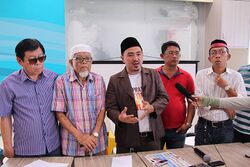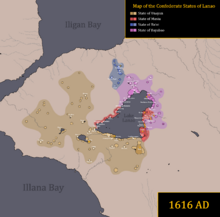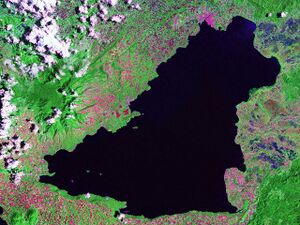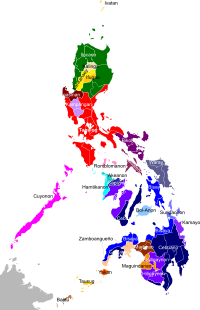ماراناو (شعب)
Bangsa Mëranaw باڠس مرانو | |
|---|---|
 | |
| إجمالي التعداد | |
| 1,800,130 (2020 census)[1] | |
| المناطق ذات التجمعات المعتبرة | |
(Bangsamoro, Soccsksargen, Zamboanga Peninsula, Northern Mindanao, Manila, Cebu) | |
| اللغات | |
| Native Maranao Also Filipino • English | |
| الدين | |
| Predominantly Sunni Islam | |
| الجماعات العرقية ذات الصلة | |
| Iranun, Maguindanao, Tiruray Lumad, Tausūg, Visayan, other Moros, other Filipinos, other Austronesian peoples |
The Maranao people (Maranao: ['mәranaw]; Filipino: Maranaw[2]), also spelled Meranao, Maranaw, and Mëranaw, is a predominantly Muslim Filipino ethnic group native to the region around Lanao Lake in the island of Mindanao. They are known for their artwork, weaving, wood, plastic and metal crafts and epic literature, the Darangen. They are ethnically and culturally closely related to the Iranun, and Maguindanaon, all three groups being denoted as speaking Danao languages and giving name to the island of Mindanao. They are grouped with other Moro people due to their shared religion.
. . . . . . . . . . . . . . . . . . . . . . . . . . . . . . . . . . . . . . . . . . . . . . . . . . . . . . . . . . . . . . . . . . . . . . . . . . . . . . . . . . . . . . . . . . . . . . . . . . . . . . . . . . . . . . . . . . . . . . . . . . . . . . . . . . . . . . . . . . . . . . . . . . . . . . . . . . . . . . . . . . . . . . . .
ماراناو
The name "Maranao" (also spelled "Mëranaw", or "Maranaw") means "people of the lake" (lanaw or ranaw, archaic danaw, means "lake" in the Maranao language). This is in reference to Lake Lanao, the predominant geographic feature of the ancestral homeland of the Maranao people.[3]
The original endonym of the ancestral Maranao is believed to be "Iranaoan".[4][5] This group later diverged, resulting in the modern Maguindanao and the Iranun people (whose names can also be translated to "people of the lake"),[6] while the ancestral Iranaoan who stayed in Lake Lanao became known as the Maranao. These three ethnic groups are still related to each other, share similar cultures and speak languages belonging to the Danao language family.[4][5]
Confederate States of Lanao
The Maranao were the last of the Muslims of the Southern Philippines undergoing Islamization, primarily under the influence of the Maguindanao Sultanate.
Like neighboring Moros and the Lumads, during the nominal occupation of the Philippines by the Spanish, and later the American and the Japanese, the Maranao had tribal leaders called datu. In the 16th century, upon the arrival of Islam, they developed into kingdoms with sultans due to the influence of Muslim missionaries.
الثقافة
Maranao culture can be characterized by:
- بحيرة لاناو
- Sarimanok (Papanoka a Məra or Marapatik)
- Torogan, Maranao royal houses, where the architecture used is the most aesthetic in the Philippines
- Darangən, an epic UNESCO Intangible cultural heritage
- Kirim, pre-Hispanic handwriting based from Arabic letters with 19 consonants and 7 vowels
- Singkil, a Philippine dance based on a scene from the Darangən[7]
- Okir wood and metal carvings
- Kapmorod and Kakhalilang with Sambolayang and Pasandalan a Morog and Marigay for Kazipa sa Manggis
- Kaplagod (racing horses)
- Tabo, a drum used in mosques to call worshippers to prayer[8]
Maranao culture is centered around Lake Lanao, the largest lake in Mindanao, and second-largest and deepest lake in the Philippines. Lanao is the subject of various myths and legends. It supports a major fishery, and powers the hydroelectric plant installed on it; the Agus River system generates 70% of the electricity used by the people of Mindanao. A commanding view of the lake is offered by Marawi City, the provincial capital.
الفنون المرئية
Woodcarving of the Sarimanok with okir motifs
Sarimanok, Papanok a "Məra" or "Marapatik" is a legendary bird of the Maranao that is a ubiquitous symbol of their art. It is depicted as a Hoodhud (Arabic) with colorful wings and feathered tail, holding a fish on its beak or talons. The head of Sarimanok is like the head of a Hoopoe (Balalatoc in maranaw) and is profusely decorated with scroll, leaf and spiral motifs (okir). It is a symbol of good fortune.[9][10]
The Maranao have also developed their own adaptation of the Ramayana epic, the Maharadia Lawana. They also have a traditional dance, the Singkil, which was based on another local Ramayana adaptation, the Darangən.
العمارة
Traditional Maranao architecture, like elsewhere in the Philippines and at large maritime Southeast Asia, follows the Austronesian framework of wooden structures on piles, divided in three tiers pertaining to social class:torogan of royalty, mala a walay of lesser nobility, and the common lawig analogous to the bahay kubo.
الموسيقى والفنون الأدائية
Maranao kulintang music is a type of a gong music. Sarunaay is also found among both Muslim and non-Muslim groups of the Southern Philippines. Kobbing is a Maranao instrument and Biyula is another popular Instrument. Biyula is a string instrument. In 2005, the Darangen Epic of the Maranao people of Lake Lanao was selected by UNESCO as a Masterpiece of the Oral and Intangible Heritage of Humanity.
المطبخ
Maranao cuisine is spicier compared to most regions elsewhere in the Philippines, a trait largely shared with much of Mindanao. Traditionally cultivated spices, locally known as palapa (Bontang, native product of Gandamatu) are a common condiment.[11] It is made of stewed sakurab scallion bulbs, ginger, and chillies in coconut oil.[12]
Dishes are intertwined with important cultural rituals across all aspects of Maranao culture: from birth to death.[13]
البنية الاجتماعية
Traditionally, Maranao society is divided into two strata. Namely, mapiyatao (pure) and kasilidan (mixed blood). kasilidan is further subdivided into categories which are as follows; sarowang (non-Maranao), balbal (beast), dagamot (Sorcerer/Sorceress) and bisaya (Slave). The mapiyatao are natives entitled to ascend to thrones by pure royal bloodline. On the other hand, the kasilidan are natives suspected of mixed bloodline. However, due to the changes brought by time, these social strata are beginning to decline due to the rise of wealth of each and every Maranao families.
الديمغرافيا
Maranaos number 1,354,542 in 2010, representing 1.47% of the population.[14] Along with the Iranun and Maguindanao, the Maranao are one of three, related, indigenous groups native to Mindanao. These groups share genes, linguistic and cultural ties to non-Muslim Lumad groups such as the Tiruray or Subanon. Maranao royals have varied infusions of Arab, Indian, Malay, and Chinese ancestry.
اللغة
. . . . . . . . . . . . . . . . . . . . . . . . . . . . . . . . . . . . . . . . . . . . . . . . . . . . . . . . . . . . . . . . . . . . . . . . . . . . . . . . . . . . . . . . . . . . . . . . . . . . . . . . . . . . . . . . . . . . . . . . . . . . . . . . . . . . . . . . . . . . . . . . . . . . . . . . . . . . . . . . . . . . . . . .
لغة مراناو المحلية ولغاتها الثانوية
Maranao is an Austronesian language spoken by the Maranao people in the provinces of Lanao del Norte and Lanao del Sur.[15] Because of the mass influx of Cebuano migrants to Mindanao, many Maranaos are also fluent in Cebuano. Tagalog is the most used language by the Maranaos, which ranks second among its native language. English is also a language recognized by its citizens.
The Mëranaw Jawi kirim script and Arabic script languages
Arabic, a Central Semitic language, is spoken by the Moro people, as it is the liturgical language of Islam. Some of the Maranaos are studied in the Middle east so they shared it in their area although it also spread throughout the Archipelago. The city of Marawi is known as the center of Islamic faith and cultures and Arabic studies in the Philippines because of its influence when it comes to Arabic learning. Even so, the Maranaos did not leave the importance of Arabic education because it is part of the research of knowledge about the Islam religion. Both Jawi script and Arabic script are also a part of the recognition of the Maranaos or all the Bangsamoro people in the Philippines.
الماراناو البارزون

- Sultan Topaan Disomimba is a traditional leader, the chairman of the 16 Royal Houses of Lanao and a long time Mayor in the town of Tamparan, Lanao del Sur.
- Japar Dimaampao is a present Associate Justice of the Supreme Court of the Philippines
- Mamintal A.J. Tamano was a Filipino statesman and a former Senator of the Philippines.
- عادل تامانو is a Filipino educator, lawyer and former politician.
- Domocao Alonto is a former Filipino politician and senator of the Philippines. In 1988, he was awarded the prestigious King Faisal Prize for Service to Islam.
- Mamintal M. Adiong Sr. was a long-time Filipino politician, serving as Governor of Lanao del Sur from 2001 until his death in 2004.
- Mamintal Alonto Adiong Jr. is the present governor of the Province of Lanao del Sur.
- Abul Khayr Alonto is a Filipino businessman and lawyer and a former Moro freedom fighter. He once became the chairman of the Moro National Liberation Front.
- Dimasangcay Pundato is a former Moro revolutionary leader and current undersecretary of the Office of the Presidential Adviser on the Peace Process. He served as the Secretary of the now defunt Office on Muslim affairs (NCMF) for 2 straight administrations.
- Samira Gutoc-Tomawis is a Filipino civic leader, journalist, environment and women's rights advocate, and legislator[1] who has served as member of the Regional Legislative Assembly of the Autonomous Region in Muslim Mindanao and a member of the Bangsamoro Transition Commission which was tasked to draft the Bangsamoro Basic Law.
- محمد سعد الدين was a journalist, peace advocate, and provincial information officer of the province of Maguindanao.
انظر أيضاً
- ماراناو (لغة)
- Iranun people
- لاناو دل سور
- بحيرة لاناو
- Confederate States of Lanao
- سلطنة ماگندناو
- الجماعات العرقية في الفلپين
- Moro peoples
- لوماد
ملاحظات ومراجع
- ^ "Ethnicity in the Philippines (2020 Census of Population and Housing)". Philippine Statistics Authority. Retrieved July 4, 2023.
- ^ [1] Archived أكتوبر 12, 2013 at the Wayback Machine
- ^ Hamilton, Roy W. (1998). From the rainbow's varied hue: textiles of the southern Philippines. UCLA Fowler Museum of Cultural History. p. 135. ISBN 9780930741648.
- ^ أ ب Lobel, Jason William; Riwarung, Labi Hadji Sarip (2009). "Maranao Revisited: An Overlooked Consonant Contrast and its Implications for Lexicography and Grammar". Oceanic Linguistics. 48 (2): 403–438. doi:10.1353/ol.0.0040. JSTOR 40783537. S2CID 145549504.
- ^ أ ب Baradas, David B. (1968). "Some Implications of the Okir Motif in Lanao and Sulu Art" (PDF). Asian Studies. 6 (2): 129–168. S2CID 27892222. Archived from the original (PDF) on January 29, 2019.
- ^ Campbell, Gwyn (2018). Bondage and the Environment in the Indian Ocean World. Springer. p. 84. ISBN 9783319700281.
- ^ https://www.youtube.com/watch?v=GzhoWsVElXo https://www.youtube.com/watch?v=c6JVSMSIYn4
- ^ "Archived copy". Archived from the original on June 28, 2021. Retrieved June 28, 2021.
{{cite web}}: CS1 maint: archived copy as title (link) - ^ "Sari-Manok". Philippines Art and Culture. Retrieved October 21, 2010.[dead link]
- ^ Madale, Nagasura T. (February 7, 2010). "Recipe in the Life of the Maranao By: Nagasura T. Madale, PhD. -Part 2". Kalopindo. Aratawata Website. Archived from the original on July 14, 2011. Retrieved October 22, 2010.
- ^ Umagang Kay Ganda (July 9, 2013). "Recipe: Maranao dish Chicken Piaparan". ABS-CBN Corporation Website. Retrieved July 9, 2013.
- ^ Rosauro, Ryan (October 17, 2010). "Munai spice may be way out of war for conflict areas". Inquirer Website. Archived from the original on October 23, 2010. Retrieved October 22, 2010.
- ^ Madale, Nagasura T. (February 6, 2010). "Recipe in the Life of the Maranao By: Nagasura T. Madale, PhD. -Part 1". Kalopindo. Aratawata Website. Archived from the original on July 14, 2011. Retrieved October 21, 2010.
- ^ "2010 Census of Population and Housing, Report No. 2A: Demographic and Housing Characteristics (Non-Sample Variables) - Philippines" (PDF). Philippine Statistics Authority. Retrieved May 19, 2020.
- ^ "Welcome". Learn Maranao Language Website. Archived from the original on October 6, 2010. Retrieved October 21, 2010.
وصلات خارجية
- Maranao
- Maranao Online
- Ranao, Ranao (Lake) terms for Lanao del Sur.
- Articles with dead external links from January 2018
- Short description is different from Wikidata
- Articles with hatnote templates targeting a nonexistent page
- Articles containing Maranao-language text
- "Related ethnic groups" needing confirmation
- Articles using infobox ethnic group with image parameters
- Ethnic groups in Mindanao
- Islam in the Philippines
- Muslim communities of the Philippines
- Moro ethnic groups





